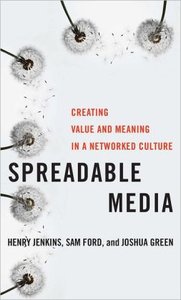Spreadable MediaCreating Value and Meaning in a Networked Culture
|

|
 Diese Seite wurde seit mehr als 7 Monaten inhaltlich nicht mehr aktualisiert.
Unter Umständen ist sie nicht mehr aktuell.
Diese Seite wurde seit mehr als 7 Monaten inhaltlich nicht mehr aktualisiert.
Unter Umständen ist sie nicht mehr aktuell.
 Zusammenfassungen
Zusammenfassungen
 Spreadable Media maps fundamental changes taking place in our contemporary media environment, a space where corporations no longer tightly control media distribution and many of us are directly involved in the circulation of content.
Spreadable Media maps fundamental changes taking place in our contemporary media environment, a space where corporations no longer tightly control media distribution and many of us are directly involved in the circulation of content. It contrasts “stickiness”—aggregating attention in centralized places—with “spreadability”—dispersing content widely through both formal and informal networks,some approved, many unauthorized. Stickiness has been the measure of success in the broadcast era (and has been carried over to the online world), but “spreadability” describes the ways content travels through social media.
Following up on the hugely influential Convergence Culture: Where Old and New Media Collide, this book challenges some of the prevailing metaphors and frameworks used to describe contemporary media, from biological metaphors like “memes” and “viral” to the concept of “Web 2.0” and the popular notion of “influencers.” Spreadable Media examines the nature of audience engagement,the environment of participation, the way appraisal creates value,and the transnational flows at the heart of these phenomena. It delineates the elements that make content more spreadable and highlights emerging media business models built for a world of participatory circulation. The book also explores the internal tensions companies face as they adapt to the new communication reality and argues for the need to shift from “hearing” to “listening” in corporate culture.
Drawing on examples from film, music, games, comics, television,transmedia storytelling, advertising, and public relations industries,among others—from both the U.S. and around the world—the authors illustrate the contours of our current media environment.They highlight the vexing questions content creators must tackle and the responsibilities we all face as citizens in a world where many of us regularly circulate media content. Written for any and all of us who actively create and share media content, Spreadable Media provides a clear understanding of how people are spreading ideas and the implications these activities have for business, politics, and everyday life.
 Dieses Buch erwähnt ...
Dieses Buch erwähnt ...
 Personen KB IB clear | Sonja Baumer , Yochai Benkler , Matteo Bittanti , danah boyd , Amy Bruckman , Susan L. Bryant , Rachel Cody , Richard Dawkins , Andrea Forte , Thomas Friedman , J. P. Gee , Becky Herr-Stephenson , E. von Hippel , Heather Horst , Mizuko Ito , Henry Jenkins , Steven Johnson , Andrew Keen , Patricia G. Lange , Jaron Lanier , Jean Lave , Dilan Mahendran , Katynka Z. Martínez , Stanley Milgram , Tim O'Reilly , C.J. Pascoe , Dan Perkel , Lee Rainie , Howard Rheingold , Laura Robinson , Christo Sims , Neal Stephenson , Lisa Tripp , Barry Wellman , Etienne Wenger , Jonathan L. Zittrain | ||||||||||||||||||||||||||||||||||||||||||||||||||||||||||||||||||||||||||||||||||||||||||||||||||||||||||||||||||||||||||||||||||||||||||||||||
 Begriffe KB IB clear |  Aufmerksamkeit / Fokus Aufmerksamkeit / Fokus attention
, chilling effect
, ContentContent
, attention
, chilling effect
, ContentContent
,  Geschäftsmodell Geschäftsmodell business model
, business model
,  Kommunikation Kommunikation communication
, communication
,  Konvergenz Konvergenz convergence
, kulturelles Kapital
, Meme
, microbloggingmicroblogging
, Naturnature
, convergence
, kulturelles Kapital
, Meme
, microbloggingmicroblogging
, Naturnature
,  Politik Politik politics
, social softwaresocial software
, storytellingstorytelling
, World of Warcraft politics
, social softwaresocial software
, storytellingstorytelling
, World of Warcraft
| ||||||||||||||||||||||||||||||||||||||||||||||||||||||||||||||||||||||||||||||||||||||||||||||||||||||||||||||||||||||||||||||||||||||||||||||||
 Bücher |
| ||||||||||||||||||||||||||||||||||||||||||||||||||||||||||||||||||||||||||||||||||||||||||||||||||||||||||||||||||||||||||||||||||||||||||||||||
 Texte |
|
 Zitationsgraph
Zitationsgraph
 Zitationsgraph (Beta-Test mit vis.js)
Zitationsgraph (Beta-Test mit vis.js)
 Zeitleiste
Zeitleiste
 7 Erwähnungen
7 Erwähnungen 
- it's complicated - the social lives of networked teens (danah boyd) (2014)


- Mediatisierte Welten der Vergemeinschaftung - Kommunikative Vernetzung und das Gemeinschaftsleben junger Menschen (Andreas Hepp, Matthias Berg, Cindy Roitsch) (2014)

- The War on Learning (Elizabeth Losh) (2014)

- Digital Sociology (Deborah Lupton) (2015)

- The Platform Society - Public Values in a Connective World (José van Dijck, Thomas Poell, Martijn de Waal) (2018)

- Wikis und die Wikipedia verstehen - Eine Einführung (Ziko van Dijk) (2021)


- Bildung und Digitalität - Analysen – Diskurse – Perspektiven (Sandra Aßmann, Norbert Ricken) (2023)


- An digitalen Medienkulturen partizipieren - Eine kritische Betrachtung des Konzepts der participatory culture (Valentin Dander, Olga Neuberger, Sandra Aßmann)


- An digitalen Medienkulturen partizipieren - Eine kritische Betrachtung des Konzepts der participatory culture (Valentin Dander, Olga Neuberger, Sandra Aßmann)
 Co-zitierte Bücher
Co-zitierte Bücher

Bowling alone
(Robert Putnam) (2000)

Confronting the Challenges of Participatory Culture
Media Education for the 21st Century
(Henry Jenkins, Katie Clinton, Ravi Purushotma, Alice J. Robison, Margaret Weigel) (2006)



Living and Learning with New Media
Summary of Findings from the Digital Youth Project
(Mizuko Ito, Heather Horst, Matteo Bittanti, danah boyd, Becky Herr-Stephenson, Patricia G. Lange, C.J. Pascoe, Laura Robinson) (2008)


Der Aufstieg der Netzwerkgesellschaft
The Rise of the Network Society
The Information Age: Economy, Society, and Culture, Volume 1
(Manuel Castells) (1996)

Hanging Out, Messing Around, and Geeking Out
kids living and learning with new media
(Mizuko Ito, Sonja Baumer, Matteo Bittanti, danah boyd, Rachel Cody, Becky Herr-Stephenson, Heather Horst, Patricia G. Lange, Dilan Mahendran, Katynka Z. Martínez, C.J. Pascoe, Dan Perkel, Laura Robinson, Christo Sims, Lisa Tripp) (2010)


 Volltext dieses Dokuments
Volltext dieses Dokuments
 Standorte
Standorte 
 Bibliographisches
Bibliographisches 
 Beat und dieses Buch
Beat und dieses Buch
Beat hat dieses Buch während seiner Zeit am Institut für Medien und Schule (IMS) ins Biblionetz aufgenommen. Beat besitzt kein physisches, aber ein digitales Exemplar. (das er aber aus Urheberrechtsgründen nicht einfach weitergeben darf). Es gibt bisher nur wenige Objekte im Biblionetz, die dieses Werk zitieren.























 , 4295 kByte)
, 4295 kByte) 



 Biblionetz-History
Biblionetz-History